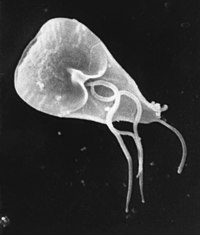
Photo from wikipedia
Recycling wastewater is becoming more common as communities around the world try to better control their water resources against an increased frequency of either prolonged droughts or intense flooding. For… Click to show full abstract
Recycling wastewater is becoming more common as communities around the world try to better control their water resources against an increased frequency of either prolonged droughts or intense flooding. For communities in coastal areas, wastewaters may contain elevated levels of bromide (Br-) and iodide (I-) from seawater intrusion or high mineral content of source waters. Disinfection of such wastewater is mandatory to prevent the spread of pathogens, however little is known about the toxicity of wastewater after disinfection in the presence of Br- and I-. In this study we compared the induction of chronic cytotoxicity in mammalian cells in samples of municipal secondary wastewater effluent amended with elevated levels of Br-/I- after disinfection by chlorine, chloramines or ozone to identify which disinfection process generated wastewater with the lowest level of adverse biological response. Chlorination increased mammalian cell cytotoxicity by 5 times as compared to non-disinfected controls. Chloramination produced disinfected wastewater that expressed 6.3 times more cytotoxicity than the non-disinfected controls and was 1.3 times more cytotoxic than the chlorinated samples. Ozonation produced wastewater with cytotoxicity comparable to the non-disinfected controls and was at least 4 times less cytotoxic than the chlorine disinfected wastewaters. These results indicate that compared to chlorination and chloramination, ozonation of wastewater with high Br-/I- levels yielded the lowest mammalian cell cytotoxicity, suggesting its potential as a more favorable method to disinfect wastewater with minimizing the biological toxicity in mind.
Journal Title: Journal of environmental sciences
Year Published: 2017
Link to full text (if available)
Share on Social Media: Sign Up to like & get
recommendations!